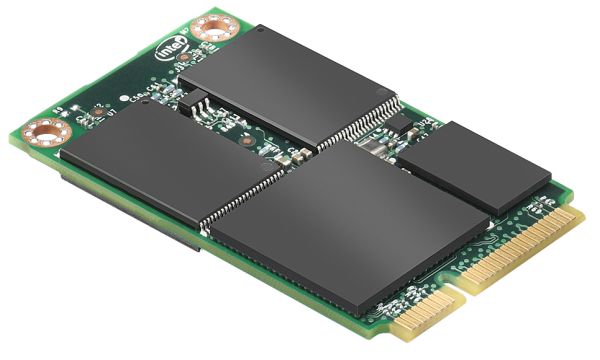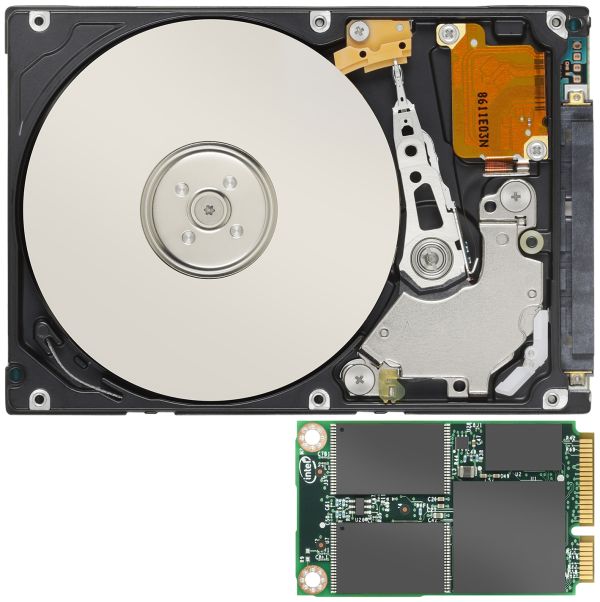Intel's SSD 310: G2 Performance in an mSATA Form Factor
by Anand Lal Shimpi on December 29, 2010 12:22 PM EST- Posted in
- Storage
- SSDs
- Intel
- Intel SSD 310
Although not quite the Intel SSD announcement we were expecting in Q4, today Intel unveiled its first mSATA SSD: the Intel SSD 310.
Based on the 34nm Intel X25-M G2 controller, the 310 will be available in both 40GB and 80GB capacities. The 80GB version should perform a bit slower than an 80GB X25-M G2 while the 40GB version will perform like a 40GB X25-V.
| Intel SSD 310 Comparison | |||||
| Intel SSD 310 | Intel X25-M G2 (34nm) | Intel X25-V (34nm) | |||
| Codename | Soda Creek | Postville | Postville | ||
| Capacities | 40/80GB | 80/160GB | 40GB | ||
| NAND | IMFT 34nm MLC | IMFT 34nm MLC | IMFT 34nm MLC | ||
| Sequential Performance Read/Write |
Up to 200/70MB/s (80GB) Up to 170/35MB/s (40GB) |
Up to 250/100 MB/s | Up to 170/35MB/s | ||
| Random 4KB Performance Read/Write |
Up to 35K/6.6K IOPS (80GB) Up to 25K/2.5K (40GB) |
Up to 35K/8.6K IOPS | Up to 25K/2.5K (40GB) | ||
| Typical Power Consumption Active/Idle | 150mW/75mW | 150mW/75mW | 150mW/75mW | ||
| Size | 50.8mm x 29.85 mm x 4.85 mm | 100.5mm x 69.9 mm x 7mm or 9.5mm | 100.5mm x 69.9 mm x 7mm or 9.5mm | ||
The 310 isn’t about performance, rather form factor. The SSD in Apple’s new MacBook Air is just the beginning - OEMs are beginning to shed the limits of traditional hard drive form factors as SSDs don’t need to house a circular platter.
The mSATA interface is physically a mini PCIe connector (similar to what you’d see with a WiFi card in a notebook) but electrically SATA. The result is something very compact.
The full sized mSATA 310 measures 50.8mm x 29.85mm and is less than 4.85mm thick. Total weight? Less than 10 grams.
The Intel SSD 310 is OEM only at this point. Lenovo has already announced it will offer the 310 in ThinkPads in the future, while DRS Technologies will show off a tablet PC next month with the 310 inside. The 40GB drive is priced at $99 while the 80GB version will run you $179 in 1000 unit quantities.
As for the rest of Intel’s SSD updated lineup? While internal roadmaps showed a Q4 release for the 3rd generation X25-M based on 25nm NAND, that product is obviously delayed. We’re also hearing that new SandForce drives are still months away so those of you eagerly waiting for new drives at the high end will have to wait a bit longer.












52 Comments
View All Comments
Tros - Wednesday, December 29, 2010 - link
Wow seriously? I thought AnandTech's readers would know well to care more about the methods, than the clocks or fab-processes.USB3 is still an ill choice for high bandwidth, not only for being a host-initiated, polling, architecture, but for stripping the controllers of their better features (DMA for instance).
The best changes this brings are in form-factors. Putting them into a RAID for a ridiculously speedy notebook doesn't make much sense though, unless it's something protective like RAID5, or ZFS (again, method trumps fab). You'll just add more controllers than you need to a set of storage. What really makes sense is creating a notebook line that only uses SSDs, and having magnets in the case to do some awesome mechanical stuff.
vol7ron - Thursday, December 30, 2010 - link
Be it as it may, I'd like a USB3/eSATA all-in-one thumb drive. Different connectors on the different ends. I'd also like to load it with Ubuntu or something similar to Ceedo.MeanBruce - Wednesday, December 29, 2010 - link
Let's hope Intel's delay or rework is due to SandForce's SF-2000 upcoming controller specs. I would love to see some Intel SATA 6Gb/sec drives and some Intel PCIe drives/cards like the Revo drives. Seems they will have to deliver something extaordinary to stay competative. 2011 is going to be a great year!liveonc - Wednesday, December 29, 2010 - link
UEFI, SandyBridge, mSATA, USB3.0, affordable ultraportables, & people still too paranoid to give up their false sense of security in favor of cloud computing...You "could" add a 5400RPM "green" HDD for storage, or just settle for that external USB3.0 storage to get added battery life & separate your mobile from your "precious" backup.
synaesthetic - Wednesday, December 29, 2010 - link
Nothing to do with a "false sense of security."More to do with not wanting to be charged for every pixel we use individually.
Granted, as long as net neutrality is enforced, cloud computing will be awesome. But if the corporatists corrupt the legislation (as they've already done to some extent), then all that cloud computing will do is give businesses free reign on charging you for everything multiple times.
solipsism - Wednesday, December 29, 2010 - link
I wonder (and hope) that the intermediate future of notebooks shed the ODD, include these drives as boot drives but off HDDs for storage in the standard size notebooks. As great a it would be to have all SSD I don’t see the cost-to-GB ratio being in the consumers favour for several years.PS: Before it erroneously gets assumed, Anand didn’t say that Apple invented or was the first to use incorporate these drives, but they are the first to make waves with it.
damianrobertjones - Wednesday, December 29, 2010 - link
If you slap in a 40Gb drive into a laptop, the support calls will be extensive, "My drive is full"Andysound - Wednesday, December 29, 2010 - link
I've thought about it since I found about the Optical-to-HDD/SSD adapters for MacBook Pro computers, as I noticed there's plenty of space left over after fitting a 2.5" drive in one of those.If someone (OWC reading this maybe/hopefully...?!) were to build a different optical-bay adapter including the hardware RAID and space to fit TWO or THREE of these new smaller SSD drives, it would be great for leaving said set-up as the hyper fast boot/OS drive, while optionally replacing the main drive with a new 1TB HDD for space reasons...
Currently my only option (still waiting for prices to drop more and the warranty to expire next April '11) is to use one of the current adapters to fit a SSD instead of the optical drive, and replacing the original disk with a 2nd identical SSD so I can RAID 'em in zero. Problem with this set-up are mixed reports thus far, and I'd loose overall capacity, meaning less mobility.
Mine is a 17" 2.66GHz i7 MB Pro w/ a 500GB 7.2k rpm HDD.
iwod - Thursday, December 30, 2010 - link
Well realistically we could have a Hybrid of HDD and a small one ( But faster version then this Intel SSD ).The OS or Filesystem would treat it as a single unit. Using SSD for Cache and HDD for less frequent files like your iPhone Backup.
However when ever i think of it this way it seems it is not a very elegant solution to solve the problem and generally add complexity to the software system.
setzer - Wednesday, December 29, 2010 - link
Now if intel could also do these for half-height mini pci-e I could replace the wireless card in my notebook by a ssd and get the best of both worlds.